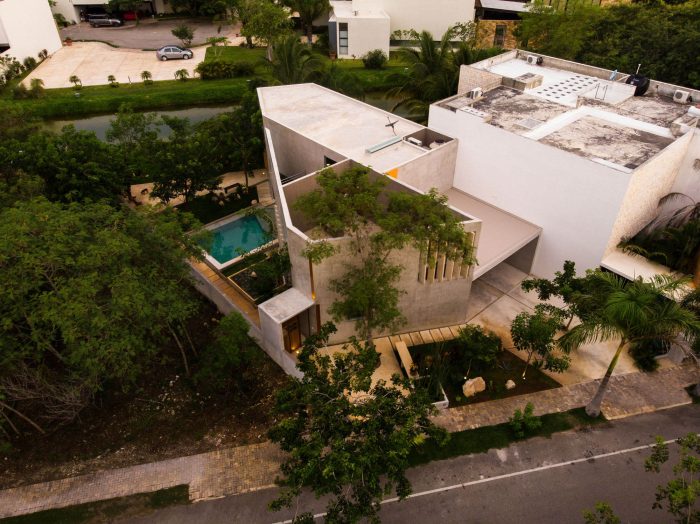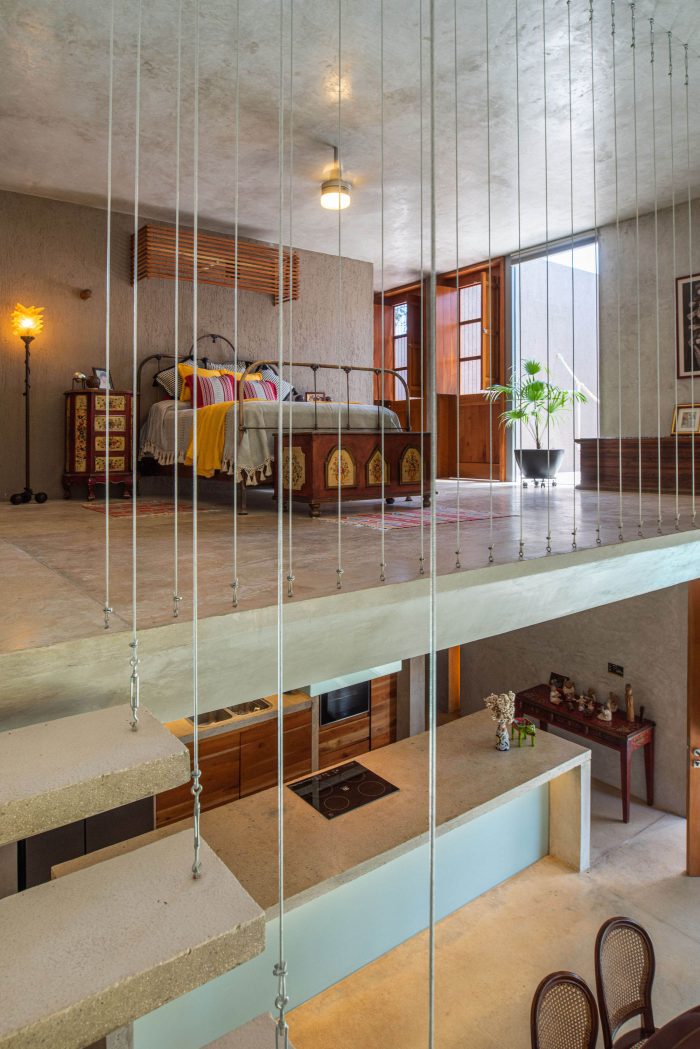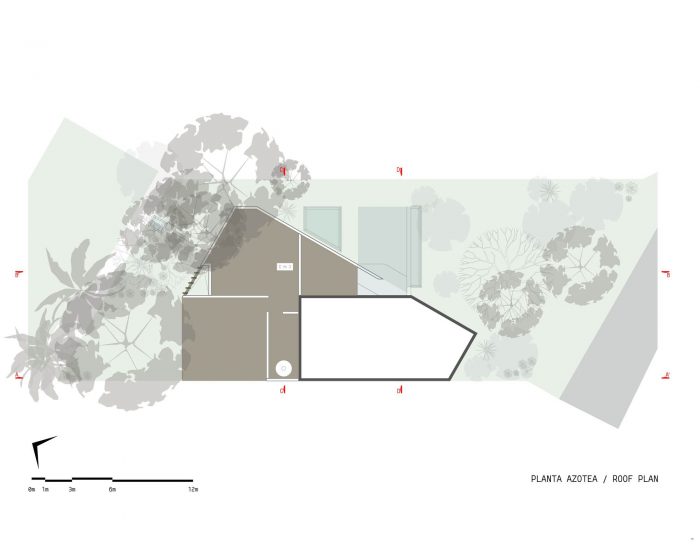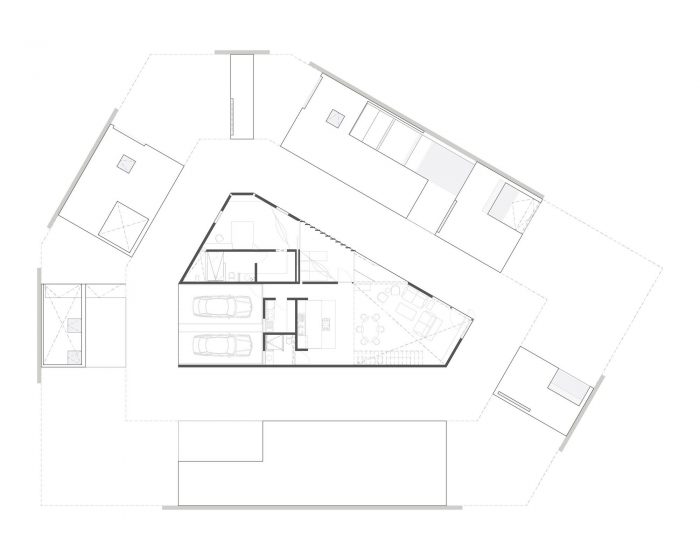Casa del Lago是一栋独立的房子,位于一个房地产开发项目内,所有的地块都紧邻后院的水体。
用户是一对多文化的成熟夫妇。该项目的目标是,房子将利用综合体的特点,开放空间将成为日常使用动态的一部分。同样,房子应该记住尤卡特坎文化,并有能力容纳业主的艺术和/或情感价值的对象的集合。
Casa del Lago is a detached house located within a real estate development where all its lots adjoin a water body in their backyards.
The users are a multicultural couple of mature adults. The objective of the project was that the house will take advantage of the characteristics of the complex and that the open spaces will be part of the dynamics of daily use. Likewise, the house should remember the Yucatecan culture and have the capacity to house the collection of objects of artistic and/or emotional value of the owners.
该建筑远离公共道路,在其一侧形成了一个袖珍公园。在这个公园里,有一个由古老的修复门界定的门槛。当穿过门槛时,由游泳池、池塘、铺装和绿地组成的开放性公共区域被部署,其对角线的位置朝向物业的相反界限,产生了一种视觉效果,使综合体的水体更接近路人,你可以与之进行初步的互动,而无需通过封闭的空间。
The building is tucked away from the public road, generating a pocket park on one of its sides. In this one there is an access threshold defined by an old restored door. When crossing it, the open public areas composed by the pool, ponds, paved and green areas are deployed, whose diagonal disposition towards the opposite limit of the property generates a visual effect that brings the body of water from the complex closer to the passer-by, with which you can have an initial interaction without having to go through closed spaces.
该建筑由双高社交区(客厅和餐厅)、厨房、客用卫生间、洗衣区、屋顶车库以及带露台、步入式衣柜和卫生间的主卧室组成。上层由一个与社交区相连的 “tapanco “组成,它具有客房、卫生间、机房和3个开放露台的功能,作为商业用途的增长储备。
The construction consists of a double-height social area (living and dining room), kitchen, guest bathroom, laundry area, roofed garage, and a master bedroom with terrace, walk-in closet, and bathroom. The upper floor consists of a “tapanco” connected to the social area that functions as a guest bedroom, a bathroom, machine room and 3 open terraces as growth reserves for commercial purposes.
体积的定义是对用户分析、开发限制和被动系统标准的应用进行协调。建筑方法是该地区最常见的,基于混凝土块、梁和板。建筑饰面明显,以降低维护成本。室内地面是混凝土,以及现场预制板,固定家具和垂直遮阳板都是用它组装的。所有的墙壁和低矮的天花板都采用了烧制的防水水泥基灰泥。梯田和外部人行道的地面由防滑的粗混凝土制成。窗户的摆放方式是为了强调室内和室外的联系。
The volumetric definition responds to the conciliation of the analysis of the users, the development’s restrictions and the application of passive systems criteria. The construction method is the most common in the area, based on concrete blocks, beams and slabs. The architectural finishes are apparent to reduce maintenance costs. The interior floors are concrete, as well as the pre-cast plates on site with which fixed furniture and vertical shades were assembled. All walls and low ceilings have a burnished waterproof cement-based stucco. The floors of the terraces and exterior pavements are made of anti-skid rough concrete. The windows were placed in such a way as to emphasize the connection between the interior and the exterior.
景观工程整合了已有的树木与业主特有的树种和观赏植物。室内设计是从与居住者的个性合作的理念中提出来的,因此便于他们的挪用,所以空间应该作为搬进他们家时引入的各种元素的画布。
The landscape project integrates pre-existing trees with endemic species and ornamental plants of the owners. The interior design was raised from the idea of working with the inhabitant’s personality and therefore facilitate their appropriation, so the spaces should serve as canvases for the various elements that would be introduced when moving in their home.
建筑师:TACO taller de arquitectura contextual
面积:220平方米
年份:2019年
摄影:Leo Espinosa、Alejandro Patrón
制造商:CASTEL、Comex、Predeco、Tecnolite、URREA
建筑项目:TACO taller de arquitectura contextual
建筑:TACO taller de arquitectura contextual
团队:Carlos Patrón Ibarra, Alejandro Patrón Sansor, Ana Patrón Ibarra, Estefanía Rivero Janssen, Joaquín Muñoz Olivera
城市:梅里达
国家:墨西哥
Architects: TACO taller de arquitectura contextual
Area: 220 m²
Year: 2019
Photographs: Leo Espinosa, Alejandro Patrón
Manufacturers: CASTEL, Comex, Predeco, Tecnolite, URREA
Architectural Project:TACO taller de arquitectura contextual
Construction:TACO taller de arquitectura contextual
Team:Carlos Patrón Ibarra, Alejandro Patrón Sansor, Ana Patrón Ibarra, Estefanía Rivero Janssen, Joaquín Muñoz Olivera
City:Merida
Country:Mexico








































